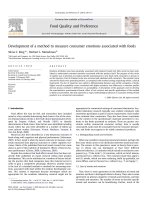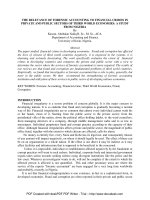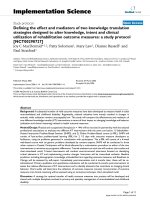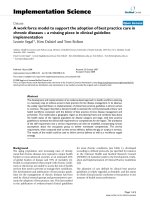Adoption and knowledge of sheep husbandry in Hills of Jammu & Kashmir, India
Bạn đang xem bản rút gọn của tài liệu. Xem và tải ngay bản đầy đủ của tài liệu tại đây (223.73 KB, 8 trang )
Int.J.Curr.Microbiol.App.Sci (2020) 9(5): 2789-2796
International Journal of Current Microbiology and Applied Sciences
ISSN: 2319-7706 Volume 9 Number 5 (2020)
Journal homepage:
Original Research Article
/>
Adoption and Knowledge of Sheep Husbandry in Hills
of Jammu & Kashmir, India
Suraj Parkash1* and Pawan Kumar Sharma2
1
Krishi Vigyan Kendra, Rajouri, 2Krishi Vigyan Kendra, Kathua, Sher-e-Kashmir University
of Agricultural Sciences & Technology of Jammu, J&K, India
*Corresponding author
ABSTRACT
Keywords
Sheep husbandry,
Adoption,
Knowledge, Rajouri
Article Info
Accepted:
23 April 2020
Available Online:
10 May 2020
A study was conducted to analyze the factors associated with knowledge and
adoption of sheep husbandry in Rajouri district of UT of Jammu & Kashmir. The
test of significance showed that adopters had higher socio-economic status as
compared to non-adopters. The test also proved that there was a significant
difference between adopters and non-adopters regarding knowledge about sheep
rearing and that adopters had more knowledge than non-adopters. 46 per cent
adopters and 30 per cent non-adopters had high socio-economic status whereas 40
per cent adopters and 36 per cent non-adopters had medium socio-economic
status. Also, 14 percent of the adopters and 34 percent of non-adopters had low
socio-economic status. 90 per cent of adopters had good knowledge about sheep
rearing compared to only 18 per cent in case of non-adopters. 50 per cent adopters
reared sheep only to earn money, 8 percent for good quality of manure and 2
percent for meat. Among the major reasons for non-adoption of sheep husbandry
were lack of space (39%), lack of finance (33%), lack of improved breeds (24%)
and susceptibility to diseases (17%).
Introduction
Agriculture has assumed vital importance in
our country in terms of both income and
employment. Farmers however remain
unemployed for 4-5 months in a year. Besides
agricultural production, the sheep farming has
been helping to great extent in providing
employment to large section of people. Sheep
farming has the additional advantage that it
does not require much capital or space and
does not involve great risk. Sheep is an
important livestock species and has four main
food security dimensions which include cash,
nutrition, food with high animal reproductive
rates and climate adaptability. Sheep
husbandry is mainly popular among women
due to their importance in fulfilling household
needs, easier accessibility and control over on
benefits (Waithanji et al., 2015). The
management practices decide derivation of
benefits from sheep, including consumption
2789
Int.J.Curr.Microbiol.App.Sci (2020) 9(5): 2789-2796
through ownership of the animals (Galiè et
al., 2015). In India they contribute greatly to
the agrarian economy, especially in the
arid/semi arid and mountainous area where
crop and dairy farming are not economical.
India ranks 3rd in the world in sheep
population after China and Australia whereas
ranks 7th in terms of mutton and wool
production (Planning Commission, 2012).
The sheep population of India has increased
from 48.76 million in 1982 to 57.49 million in
1997 to 71.56 million in 2007 (Planning
Commission, 2012). However, 19th Livestock
census of India recorded sheep population of
65.069 million (19th Livestock Census of
India, 2014). Sheep husbandry plays an
important role in the livelihood of large
percentage of small and marginal farmers and
landless labourers. A number of rural based
industries use wool and sheep skins as raw
material. Sheep manure is an important source
of soil fertility. A lot of infrastructure in the
form of sheep breeding and production
facilities, such as sheep breeding research
stations was established and research
technologies
generated.
Development
programmes were also taken up in different
states by setting up sheep and wool extension
centres, intensive sheep development projects
and large sheep breeding farms for producing
exotic and superior native rams. Sheep
development has also been made an integral
part of the IRDP.
Adoption of innovations means application of
an innovation and its continuous use (Rogers
and Shoemaker, 1971). The establishment of
Farm Science Centres (Krishi Vigyan
Kendras) in every district aims at
development of both agriculture and animal
husbandry sectors. In-spite of all these efforts,
the achievement has not been satisfactory in
terms of expected and requisite impact on
adoption of sheep husbandry. There were
many studies conducted in India to find out
the factors affecting the adoption of sheep
husbandry and the scientific practices, as
conducted
by
Satyanarayana
and
Jagadeeswary (2010); Reddy et al., (1998);
Sharma and Reddy (1998) and Meena and
Singh (2012).
The present study was conducted in Rajouri
district of UT of Jammu and Kashmir to
identify the factors behind the adoption of
sheep husbandry and thus to suggest measures
for boosting the adoption of sheep husbandry
and better implementation of state sponsored
programmes for its development.
Materials and Methods
Profile of study area
The Rajouri district of UT of Jammu and
Kashmir is situated between 320 98’ and 350
52’ North latitude and 740 01’ to 740 23’ East
longitude. The district touches Poonch,
Pulwama, POK in the west and Jammu in the
south. Rajouri District is ideally suited for
sheep and goat rearing owing to its
topography and agro-climatic conditions and
a host of other natural endowments. About
60% of rural population is directly or
indirectly benefited from Sheep Husbandry.
The Small Ruminants rearing is the Prime
mean of livelihood of the Nomads Gujjer,
Bakerwal and Gaddi communities. The small
and marginal farmers of plain belt also rear
sheep and goats in whole of plain belt mainly
for Mutton production sheep are being
crossed with Hissar Dale, Rambi×Nali×Sonali
crosses. For the migratory sheep flocks owned
by the nomads’ emphasis have been laid on
introducing the dual type sheep which have
the traits for producing the good quality wool
and fair carcass quality for mutton production
beside fine wool breeds. The Rambouillet and
Merino crosses procured from govt. owned
sheep breeding farms have been introduced in
to this area. The quality Rams are provided to
the sheep owners free of cost for the breeding
2790
Int.J.Curr.Microbiol.App.Sci (2020) 9(5): 2789-2796
purpose. At present 70% to 80% of sheep
population have been brought under the ambit
of cross-breeding for fine wool production
and are at varying level of up gradation. The
Bakerwal tribe is the main tribe which is
engaged in sheep rearing activities. In Rajouri
District about 12% population is comprised of
Bakerwals (Nomadic tribes) and mostly rear
cattle and they are herdsmen of buffaloes.
They sell surplus animals and their subsidiary
products and buy maize, rice and grocery
from the villages for day-to-day consumption.
A list of Eighty two villages of Rajouri Block
of District Rajouri was obtained from Block
Development Office Rajouri. Five villages
(Chatyar, Godhar, Sarnoo, Potha and Bagla)
from the list were selected randomly and then
from each village, list of adopters and non
adopters were made. From the prepared list of
adopters and non-adopters, ten adopters and
ten non-adopters were selected randomly.
Thus, 100 respondents from five villages were
selected which includes fifty adopters and
fifty non adopters of Sheep as subsidiary
occupation. Information and opinions were
obtained from all the respondents through
personal interview with pre-structured and
pre-tested schedule. Some of the important
factors were listed in the schedule and
respondents were asked to give reasons which
led them to adopt sheep rearing. Like-wise
non-adopters were asked to give reasons
which prevented them from adopting sheep
rearing. ‘z’ test and ‘t’ test were applied to
compare the adopters and non-adopters in
terms of their socio-economic status,
knowledge level and reasons behind adoption
of sheep rearing as subsidiary enterprise.
Results and Discussion
Socio-economic status of respondents
The socio economic status of respondents was
measure with the scale used by Trivedi and
Pareek (1964) with some modification. A
number of sub items were taken namely;
Caste, Education, Occupation, Size of family,
Type of family, number of sheep, Income,
Land holding, Housing, Social participation,
Material possession and each sub item was
given score. Then total score of each
respondent was computed. The score
distribution of adopters and non-adopters are
given in Table 1. It can be observed that most
of the adopters belong to higher socioeconomic status.
To find out relationship between adoption of
sheep rearing and socio-economic status, the
following null hypothesis was tested by z test.
The scores of socio-economic status for both
adopters and non-adopters were presented in
Table 2.
Null hypothesis (H0)
There was no significant difference in the
socio economic status of adopters and nonadopters (Table 2) and therefore the null
hypothesis cannot be accepted.
Since the calculated value of Z is greater than
the table value of Z (1.96). Therefore null
hypothesis was rejected and research
hypothesis was accepted. Therefore it may be
concluded that adopters have high socioeconomic status as compare to non-adopters.
Knowledge of respondents about sheep
rearing as a subsidiary occupation
The knowledge of respondents about sheep
rearing was determined by a set of twelve
questions. The respondents were divided into
three categories namely; poor, average and
good on the basis of knowledge score
obtained by them and as presented in Table 3.
The Table 4 indicates that majority of
adopters (90%) had good knowledge of sheep
rearing, as contrast to only 18 percent in case
of non-adopters which obviously had majority
percentage (60) under poor knowledge
category.
2791
Int.J.Curr.Microbiol.App.Sci (2020) 9(5): 2789-2796
To find out if there is any significant
difference between adopters and non-adopters
with regard to their knowledge about the
sheep rearing as subsidiary occupation, the
following null hypothesis (H0) was used for
testing.
Null hypothesis (H0)
There was no significant difference in the
knowledge regarding sheep rearing between
adopters and non-adopters.
To test the hypothesis, the knowledge score of
12 statements were arranged which are given
in Table 4. The ‘t’ value was calculated to test
the proposed hypothesis.
As the calculated value of ‘t’ (20.38) is
greater than the table value, null hypothesis
may be rejected and it may be concluded that
there was a significant difference between
adopters and non-adopters, with regard to
their knowledge about sheep rearing. The
adopters had more knowledge about sheep
rearing than non-adopters, as indicated by
higher average score for adopters (43.92) than
the non-adopters (28.92).
Factors associated with adoption of sheep
rearing
The factors associated with adoption of sheep
rearing were assessed through the answers
given by the respondents (adopters) to a
number of questions asked to them and are
presented in Table 5. The major reason
behind adoption of sheep husbandry is to earn
the money which could supplement the
agricultural income of farmers in Rajouri
district of Jammu and Kashmir. The results
are in line with Beyene et al., (2018) and
Etalema and Abera, 2018), who also revealed
that argued that generation of cash income
was the main reason for keeping small
ruminants.
Factors associated with rejection of sheep
rearing
The factors associated with rejection and nonadoption of sheep as subsidiary occupation
was assessed by asking relevant questions to
selected non-adopters, the detail of which has
been presented in Table 6.
The majority of non-adopters (78%) did not
keep sheep due to lack of space. Among other
major reasons for non-adoption were lack of
finance (66%), lack of good breeds (48%),
lack of cooperation from the government
(38%), disease susceptibility (34%), feed
unavailability (22%) and lack of time to
attend sheep (26%). Caste prejudices and nonpreference for sheep meat and milk were the
other minor reasons mentioned by nonadopters.
Table.1 Comparison of socio-economic status of the respondents (N=100, A=50, NA=50)
Category
Low
Medium
High
Score interval
Below 20
Adopters (A)
7
(14.00)
20
(40.00)
23
(46.00)
20-30
Above 30
Figures in parentheses indicate percentage
2792
Non-adopters (NA)
17
(34.00)
18
(36.00)
15
(30.00)
Int.J.Curr.Microbiol.App.Sci (2020) 9(5): 2789-2796
Table.2 Showing socio-economic score of the respondents (N=100, A=50, NA=50)
S.
Scores
S.
Scores
No. Adopters Non-adopters No.
Adopters
Non-adopters
43
30
26
25
27
1
19
34
27
27
32
2
11
23
28
39
24
3
16
32
29
29
31
4
14
36
30
31
35
5
25
21
31
32
16
6
23
24
32
34
21
7
23
29
33
31
22
8
11
25
34
28
18
9
20
20
35
34
31
10
31
27
36
35
19
11
39
26
37
34
20
12
32
33
38
19
19
13
35
19
39
30
43
14
33
23
40
29
16
15
25
24
41
27
31
16
33
19
42
28
33
17
30
32
43
30
34
18
24
18
44
29
24
19
33
26
45
32
30
20
26
16
46
28
21
21
19
23
47
33
32
22
32
31
48
29
16
23
31
25
49
32
21
24
34
27
50
32
20
25
Mean (X) = 28.38 and Mean (Y) = 25.58
Calculated value of Z= 2.15; Table value of Z=1.96
Table.3 Showing the knowledge score and knowledge categories of respondents
(N=100, A=50, NA=50)
Categories
No. of Respondent
Adopters
Non-adopters
1
30
Poor (5-10)
(2.00)
(60.00)
4
11
Average (10-15)
(8.00)
(22.00)
45
9
Good (15-20)
(90.00)
(18.00)
2793
Int.J.Curr.Microbiol.App.Sci (2020) 9(5): 2789-2796
Table.4 Knowledge score of respondents (N=100, A=50, NA=50)
Statement
Adopters
Non-adopters
47
38
1
43
38
2
49
34
3
43
20
4
49
36
5
47
32
6
44
32
7
47
26
8
29
17
9
38
18
10
46
26
11
45
30
12
Mean (Adopters) = 43.92 and Mean (Non-Adopters) = 28.92
Calculated ‘t’ value = 20.38
Table value of ‘t’ at 22 d.f. and 0.05 alpha level = 2.074
Table.5 Factors associated with adoption of sheep rearing
Factors
No. of
Adopters
50
(100.00)
2
(4.00)
8
(16.00)
2
(4.00)
0
(0.00)
To earn money
For meat
For good quality of manure
To utilize spare time
Any other
Table.6 Showing factors associated with rejection of sheep rearing
Factors
Susceptibility of disease
Unavailability of feed
Caste prejudices
Lack of space for keeping sheep
Lack of time to attend sheep
Do not eat meat and drink milk
Lack of co-operation from govt.
Lack of good breeds
Lack of finance
No. of non-adopters
17 (34.00)
11 (22.00)
4 (8.00)
39 (78.00)
13 (26.00)
2 (4.00)
19 (38.00)
24 (48.00)
33 (66.00)
2794
Int.J.Curr.Microbiol.App.Sci (2020) 9(5): 2789-2796
The main limitations in sheep husbandry
highlighted in earlier studies were lack of
artificial insemination under field conditions
due to migratory and semi-migratory
practices, illiteracy among sheep farmers,
their prejudices and convictions and
difficulties in the preservation and storage of
ram semen, fodder scarcity, non-availability
of required food, poor credit facility, unremunerative price, poor veterinary facility
etc. (Saha et al., 1994; Rathore, 2004; Narain
and Kar, 2005, Senthil and Meganathan,
2005; Singh et al., 2006).
In conclusion, there was a significant
difference between the attitude of adopters
and non-adopters towards sheep rearing as a
subsidiary occupation. Adopters had higher
level of knowledge in sheep rearing than nonadopters. The main motivational factor behind
the adoption of sheep husbandry was profit
whereas the limiting factor was the lack of
space for rearing sheep. Sheep husbandry was
as important enterprise for supplementing
income of rural households and therefore
steps need to be taken by government
agencies to eliminate limitations in sheep
husbandry. Among the adopters, scientific
sheep husbandry practices should be
promoted for enhancing profitability.
References
Beyene A, Alilo A, Mola M. 2018.
Assessment of sheep and goat (small
ruminants) production system in Esera
District, of Dawro Zone, Southern
Ethiopia. Journal of Advanced Dairy
Research 6: 2.
Etalema S, Abera A. 2018. Small ruminant
production and constraints in Misha
Woreda, Hadiya Zone, Southern
Ethiopia. International Journal of
Livestock Production 9: 192-197.
Galiè A., Mulema A., Benard M A M, Onzere
S N and Colverson K E. 2018.
Exploring gender perceptions of
resource
ownership
and
their
implications for food security among
rural livestock owners in Tanzania,
Ethiopia, and Nicaragua. Agriculture
and Food Security, 4:2.
Kumar G S and Meganathan N. 2005.
Marketing of Sheep/ Mutton. Indian
Journal of Marketing 19(3): 52-60.
Meena M L, Singh D. 2012. Adoption level of
sheep farming practices by the farmers
in arid zone of Rajasthan. Indian
Journal of Small Ruminants 18(1): 157159.
Narain P, and Kar A. 2005. Drought in
Rajasthan: Impact, Coping Mechanism
and Management Strategies. Central
Arid Zone Research Institute, Jodhpur.
Planning Commission. 2012. Report of the
working group on animal husbandry
and dairying 12th five year plan (201217). Government of India, New Delhi.
Rathore J S. 2004. Drought and household
coping strategies: A case of Rajasthan.
Indian
Journal
of
Agricultural
Economics 59: 689-708.
Reddy G R, Rashid M A and Reddy P R.
1998. Adoption of sheep and goat
husbandry practices by farmers in
Gunter district of Andhra Pradesh.
Journal of Research, ANGRAU 25(3):
49-53.
Rogers E M and Shoemaker F F. 1971.
Communication of Innovation: A Crosscultural Approach. Second Edition. The
Free Press, New York. 476p.
Saha A, Love H A and Schwart R. 1994.
Adoption of emerging technologies
under output uncertainty. American
Journal of Agricultural Economics 76:
836-846.
Satyanarayan K and Jagadeeswary. 2010. A
study on knowledge and adoption
behaviour of livestock farmers. Indian
Journal of Animal Research 44(2): 100106.
2795
Int.J.Curr.Microbiol.App.Sci (2020) 9(5): 2789-2796
Sharma G R K and Reddy K V R. 1998.
Impact of training programmes on level
of adoption of improved practices
among sheep farmers. Mysore Journal
of Agricultural Sciences 32(3): 233-235.
Singh D R, Kaur S and Sivaramane N. 2006.
Migratory sheep and goat production
system: the mainstay of tribal hill
economy in
Himachal
Pradesh.
Agricultural
Economics
Research
Review 19: 387-398.
Waithanji E, Njuki J , Mburu S, Kariuki J,
Njeru F. 2015. A gendered analysis of
goat ownership and marketing in Meru,
Kenya. Development in Practice, 25:
188-203
Wodajo H D, Gemeda B A, Kinati W, Mulem
A A, Eerdewijk A V, Wieland B. 2020.
Contribution of small ruminants to food
security for Ethiopian smallholder
farmers. Small Ruminant Research.
184:
106064.
/>20.106064
How to cite this article:
Suraj Parkash and Pawan Kumar Sharma. 2020. Adoption and Knowledge of Sheep Husbandry
in Hills of Jammu & Kashmir. Int.J.Curr.Microbiol.App.Sci. 9(05): 2789-2796.
doi: />
2796









